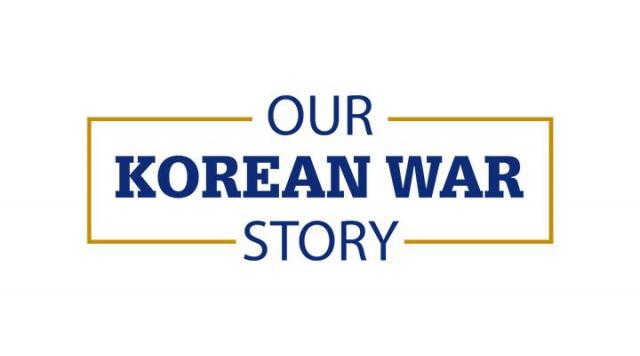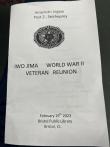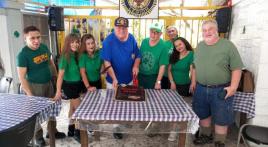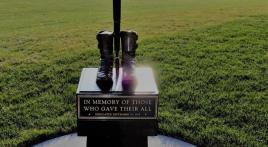I was a young man in 1949, just graduated from high school and facing what to do to prepare myself for my life journey. I had two years of Army ROTC in high school but had not considered using that experience during that period But upon graduation it became perfectly clear I did not have a path moving forward. There were very few jobs available and I had no idea what my next step should be. My stepfather suggested maybe a tour with one of the services might be beneficial. So myself and seven others went to the local enlistment office and what was to be the Air Force. I was last in line and noticed the Army recruiter was not busy at all. I drifted over to talk to him and he said I needed to join the Army inasmuch as my ROTC would be an asset. I was 17 at the time and he said my parents would need to OK any decision I made. He came and visited with my parents and they were quick to give their permission. So on July 10, 1949, I joined and immediately was assigned to basic training at Fort Ord, Calif. After graduation from basic I thought about a career in some administration and proceeded in that direction. But quite quickly information came out about a conflict going on in Korea and I became concerned. I did not suspect that just a few short years from the end of WWII. They had told all of us doing basic training that we were infantry first, and I saw that playing out. I received orders on 19 August 1950 sending me to Japan, where I would be sent to Korea. Then on to Camp Drake, Japan, on 29 August. I had time to think what had happened, and the thoughts weren’t encouraging. This was not what I had expected such a short time before. Upon landing, we were ushered into a huge hangar. There were at least 10,000 of us, all seeming very anxious. A master sergeant stepped up to a microphone and the first words he spoke were, “it didn’t matter what you were doing before, we are all infantry now.” And those words I heard in basic came back to me. We were assigned barracks and told to be prepared to assemble during the night to hear which unit we would be assigned to. There were four alerts that night and each time I waited for my name to be called. There were Marines as well as Army. Mine was never called. The next morning I was assigned to Gen. MacArthur’s headquarters in Tokyo. I was assigned to the 10th Corps Combat Engineer Group.
On 11 September 1950 a huge ship named General Simon B Buckner arrived and we were ordered to board to be part of an invasion force that would land at Inchon, Korea, in support of troops already fighting in the southern part of Korea. On 15 September 1950 we loaded on landing crafts and headed ashore to Inchon. First the Marines and then us. As we entered into Seoul it was sheer devastation. After eight days of shelling there were no buildings left. And it was so cold that we used blow torches to soften the ground so our tent poles could be pounded in. Stoves that burned kerosene were used for warmth, and we burned them so hot the tops would turn bright orange.
On 15 September 1950 everyone who participated in the landing was given an automatic promotion to the next rank. I was promoted to corporal. The battle moved rapidly and we pushed the North Koreans out of Seoul. Then the Marines and our corps boarded another ship, sailed south to Pusan, continued around the southern end of South Korea and back up north on the west side up to North Korea. On 31 October 1950 we invaded Wonsan, a move MacArthur said was our “home by Christmas” drive. Quickly moving from Wonsan to Hamhung just south of the 40th parallel, we were well on to meeting our objective. I stayed in a home in Hamhung for the night and was surprised to see an organ and other modern-day things. This part of Korea was more advanced technically than their southern neighbors. It was now November; we were hoping to see the end of this battle shortly. We moved north from Hamhung in December and on up to the Yalu River on the edge of China.
After numerous warnings not to be in North Korea, China came across the border and attacked in full force. They had many soldiers, so doped they had no fear of their lives. The first echelon had weapons and those that followed had none. As the first line fell the second picked up their weapons and kept coming. At that point MacArthur ordered us to retreat. He was already falling out of favor with President Truman, who didn’t want China to get involved, and felt MacArthur had overstepped his authority. We were ordered to retreat to Hungnam where ships would get us back to South Korea. As combat engineers, our assignment was to blow up any gear that could not be brought back. We blew up trucks and fired up some of the railroad engines and drove them onto bridges where we blew them up as well. We were the last to board and thanks to the Navy, they kept the enemy at bay so we could make it safely aboard USS Mount McKinley. Any hope of being home by Christmas was dashed.
In January 1951, we headed back to South Korea. The same month we landed and arrived at Pango-dong, South Korea. From there we moved to Taegu, South Korea. By February 1951 we had advanced to Andong, South Korea. Finally in March 1951 we were just north of the 37th parallel at Wonju, By June 1951 we had advanced to Hongch’on, South Korea. We were moving a lot and I didn’t know what the outcome would be. Fortunately that was my last move. On 24 Sep 1951 I was promoted to staff sergeant (E5). I was 20 years old. Following that, on 23 Dec 51, I was promoted to sergeant first class (E6). On 26 Jan 52 I rotated to the United States. My rank was temporary, meaning if I didn’t perform well the service could return me to my permanent rank of corporal. My first processing began at Travis AFB, Calif.

My Korean story
Camp Atterbury - Indianapolis, IN
May 8, 2022
Post:
Camp Atterbury
Submitted by:
Buddy L. Bowler




